ABSTRACT
There has been a conventional distribution channel in Japan’s agricultural industry. However, due to IT infrastructure development and lifestyle changes in consumers, e-commerce businesses have been growing rapidly and are now popular together with other important sectors in Japan. In this industry, lots of players provide e-commerce platforms. In this situation, producers have new opportunities to add more value by using internet environment in the direct distribution channel. To make e-commerce business successful, farmers need to implement organized platforms and operations. E-commerce owners also have to ensure compliance and integrity to run virtual market place. On the other hand, additional costs will incur to acquire customers. Key drivers for making success in e-commerce are product value, marketing, media control and customer list. In the e-commerce operations, traders have various options to outsource some operations and to concentrate on production. Otherwise traders can manage all operations by themselves with their own resource depending upon their business policies. E-commerce has new opportunities for farmers using internet environment.
Keywords: Direct distribution, marketing, platform, post harvest treatment, risk management
INTRODUCTION
In order to better understand the market trend as well as challenges in the internet business, this survey was conducted through a research work in Japan’s markets, literatures published in Japan and government database. Market data was extracted from information from public and private organizations as well as government offices. Core part is to consider new opportunities for growers, who have been relying on traditional distribution channel, to be able to develop direct distribution model. In this paper, success factors in agricultural e-commerce are discussed from a marketing perspective. Major approaches widely taken in internet business models are also applied to agricultural e-commerce businesses.
AGRICULTURAL E-COMMERCE
Internet usage in Japan
IT infrastructure has been improved and internet connection speed is much faster than in the past. In addition, lots of devices were developed, therefore, many consumers can easily access various websites via internet on a daily basis.
According to the Ministry of Internal Affairs and Communication, 83.4% of the population use internet in 2020. In the last 11 years, almost 80% of Japan’s population used the internet and this number represents the internet is an important tool. In terms of device, smart phone is the major tool to use internet services. In 2020, smart phone covers 68.3% of internet use. The purpose for internet use is not only for searching some information, but it is an important tool for purchasing materials. Currently food is one independent sector in the internet market place.
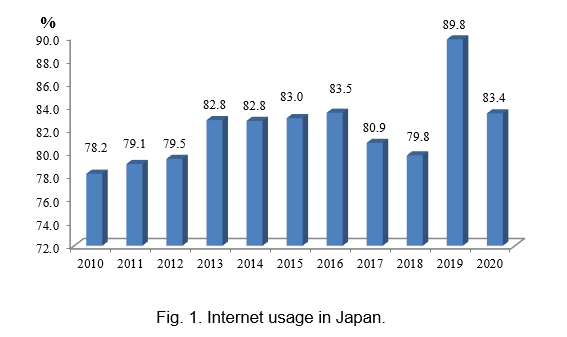
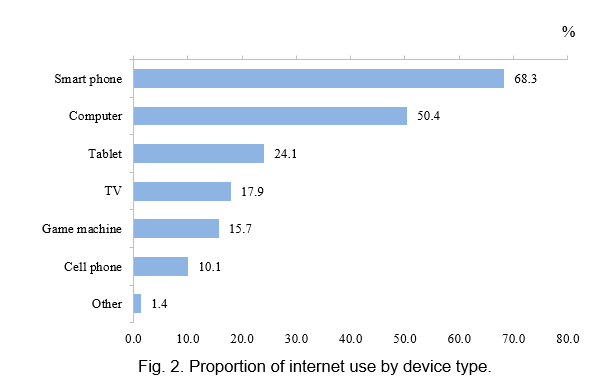
Agricultural e-commerce in Japan
In Japan, lots of organizations run e-commerce sites which have a role on portal sites. They are providing platform for e-commerce for producers to access directly to consumers. Under the conventional distribution system, farmers rely heavily on wholesalers and/or distributors in terms of marketing. However, under the internet platforms, farmers have more chances to present their activities and to make their agricultural production process more visible. This has an additional value for producers to attract consumers. Local cooperatives provide their own products through those sites. Figure 4 represents the portal sites to introduce local fresh products by JA.
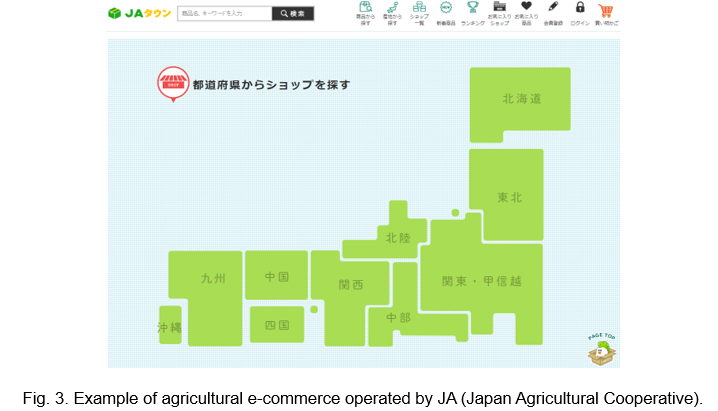
Diversity in agricultural distribution in Japan
Conventional distribution was managed by Coop at local level and agricultural products have primarily been distributed in Japan via Zenno network. This channel is still the primary channel, but currently the products are supplied to wholesalers and consumers through a more direct channel.
Other distribution channels are local farmers’ markets located in each prefecture in Japan. At present, more than 15,000 markets exist. Major network is a market place network along with national routes, managed by the Ministry of Land and Transportation. This network is called by “Michi no eki”. This facility normally has gas station, restaurant, café, gardening shop as well as farmers’ market, which is sourced from local production area.
In order to develop the distribution channel of tropical fruit, original approach for market access is needed other than conventional distribution such as JA (Japan Agricultural Cooperative). Additionally, it is important to establish direct relationship with market or resellers to develop direct distribution channel to earn profit. This approach is able to seek opportunities to develop profitable and sustainable distribution channels.
Currently more and more growers are trying to promote their products via internet shops. Given the fact that more and more consumers search products via internet, the research for e-commerce of tropical fruit is also necessary.

E-commerce platform
When producers run the e-commerce business, fulfilment operations need to be implemented to control the products, order taking, delivery, collection, customer list, etc. Those operations can be managed by their own resources, but at the same time, producers have to spend time for those areas. Other options is to outsource to a so-called fulfilment service company although its cost will depend on the service level. Producers need to make a decision for those operations to be taken in-house or outsource this to see the cost and benefit. In other words, traders can manage all operations by themselves and maximize the value and make profit from e-commerce with their own resources for developing internet shops, marketing strategies, and other promotional activities.
Fulfilment services are provided by the companies which run call-center service, distribution service, delivery service, online payment service, etc.
Major players in e-commerce
Currently in Japan, e-commerce for agricultural products is run by Japan Agricultural Coop, General Merchandize Stores, star-up companies dedicated for foods, etc. Major platformers are providing virtual market place by leveraging existing real shop network and internet business operations. Other than these channel, farmers can use fulfilment services and outsource e-commerce operations.
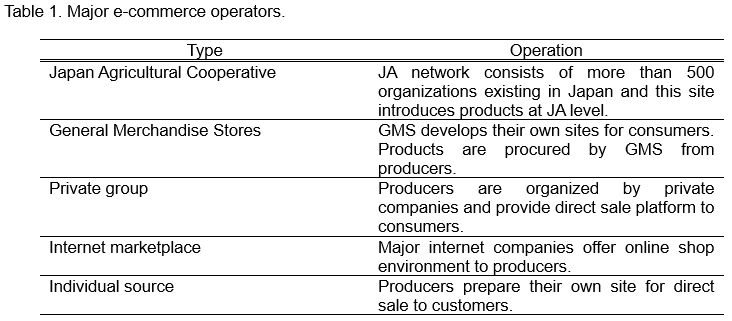
Consumers preferences
Based on the research by Japan Finance Corporation, consumers’ top 3 focus is on healthy foods, and their simplicity and reasonable prices. E-commerce traders need to consider those points when implementing marketing strategy.
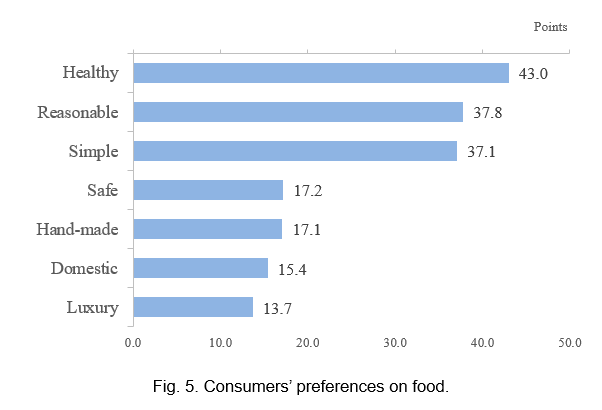
Key success factors in e-commerce
Compared to the traditional distribution process, there are a couple of drivers for success in the internet business. In addition to production of quality materials, e-commerce traders need to present their value of the products, to make visible in their agricultural operations, etc. Those activities via internet can be a communication with possible customers and will lead to develop new markets. These factors are important from a marketing perspective to acquire customers in the e-commerce business. There has been a mail order system in the distribution and there are common factors to drive internet sales generation:
- Value of products;
- Media control;
- Marketing strategy; and
- Customer management
Major transaction types in agricultural e-commerce are B to C (Business to Consumer) or C to C (Consumer to Consumer), therefore, customer management is necessary to maintain e-commerce operations. On the other hand, there are customers concerns in the internet business and mitigation of those concerns will make e-commerce operations successful.
If producers manage e-commerce through their own resources, producers have to control information management via internet. This area can be outsourced to vendors with additional costs in e-commerce business. In addition, producers have chances to provide information about themselves and introduce the values of their services via internet. This will help consumers understand the producers’ activities, concept, and management approaches. This process also has an opportunity to ensure that the growers are producing safe products. At the same time, they can use this virtual communication process to make their production process visible to end users.

Importance of marketing
In order to leverage internet environment, supplier needs to pay more attention to marketing. Farmers have their own products and recognize the value of those products. As consumers prefer safe products, reliable product sources, visibility of producers, etc. The suppliers also need to identify product value and provide as much information as possible to be able to pull and attract more customers.
In terms of marketing activity, one of the challenges is how to present product value to possible consumers. When the product is distributed via conventional sales channel, pragmatic product marketing activity is owned by the distributors. If producers are expanding to sales channel to e-commerce, value-add actions need to be taken by themselves. This role will have another burden to producers from a business perspective. This role can be outsourced to vendors although additional cost will be incurred.
Customer acquisition approach
In order to acquire new customers, suppliers may take some different approaches. First case is to make advertisement of the products and/or services, limited sales, tie-in products sale, possible customer introduction, etc. Second case is to provide samples and/or free-of-charge trials, then direct recommendation to customers.
Additionally, new customer development is an important process to grow this business model. Producers need to implement promotional activities to attract possible customers. Producers’ continuous effort to present their own products, production process, policies, etc., is expected to pull the possible customers and add value to the services. Effective promotion is needed to acquire customers and make them choose the products in the internet market place.
Supply chain management
Optimization of supply chain is a key to deliver fresh fruits from the source location to the market. Packaging is an important aspect to distribute products in the Japanese market. The same goes to domestic products. For example, fresh fruits are carefully packed and controlled by high level of quality. With respect to packaging, most of consumer products are contained in a clean package. At the same time, source location is indicated. At the premium supermarkets in Japan, local fruits and tropical fruits are sold together, therefore, customers can easily compare the products from various stand points. In the case of tropical fruits, some domestic products are also available so that attractiveness is an important factor for promoting imported materials.
Product quality control
One of the challenges in agricultural e-commerce is how to manage quality for fresh products. Those products can easily be damaged during distribution process and it will risk credibility of the product. This situation will also have a risk to lose customers and reliability is not easy to recover. If producers supply fresh foods, proper post harvest treatment is needed to keep freshness during the transportation.
Collection
Business cannot be complete if there are problems in cash collection. In the e-commerce, traders can choose the best way of collection from various options. Normally, this function is one of core parts of outsourcing services and it is valuable to mitigate the risk from an e-commerce traders’ perspective.
Compliance
Producers need to comply with laws and regulations associated with e-commerce. In the case of Japan, e-commerce traders should meet with requirements in terms of food safety, display, drug, protection of consumers, human health, etc. Participants in e-commerce should follow those regulations. Once it is violated, traders will lose credibility and will be in a difficult situation to recover the reliability of the business.
Risk management in e-commerce
Producers need to pay attention to various laws to control safety as well as to protect consumers especially in the food business. Not only to comply with relevant laws, but also suppliers had to establish processes to manage customers ’private information and users’ negative comments in internet environment. Weak management of informationcould result in damage for the suppliers. In addition, collection from customers need to be ensured in the direct distribution processes. Suppliers should consider alternatives such as advance payment, credit card payment, etc.
Opportunities in internet distribution process
Given the fact that internet is used widely in Japan, it is expected that agricultural products will be more available and sold via internet. At this point in time, various vendors exist in the market place which vary from JA network to start-up e-commerce companies.
CONCLUSION
E-commerce is expected to continue growing in the area of agricultural products distribution. Benefit of e-commerce is to be independent from traditional distribution channel and is able to maximize the profit by suppliers. At the same time, strong competition is also anticipated in the virtual market place, therefore, suppliers need to develop strategies to provide their products and brands. The challenge in the e-commerce model is that suppliers need efforts to promote their products primarily through their own resources. On the other hand, there are opportunities to save on costs such as commissions which would be needed in the conventional distribution model. It is not so easy to replace traditional distribution channel via wholesalers by the internet shop because senior generations are not familiar with internet use like the younger generation. Although there are various challenges in internet business operations, e-commerce traders have various benefits as they can provide producers’ information directly to consumers who prefer safe and reliable products. It is anticipated that e-commerce will give farmers more chances to develop new markets and to acquire new customers.
REFERENCES
Ministry of Agriculture, Forestry and Fishery. 2020. White paper for food, agriculture and farm, 2020. Norin Toukei Kyoukai Publications (Japan).
Ministry of Internal Affairs and Communication. 2022. White paper for information and communication.
Japan Finance Corporation. 2021. Research about consumers’ trend. (https://www.jfc.go.jp/n/release/pdf/topics_220222a.pdf)
Kimie Tsukuba. 2009. Better understand of industry trend and mechanism in agriculture. Shuwa System Corporation. 235p.
Iknou. 2009. Mail order. Free People Corporation. World easiest, Structure and business flow in industry. 176p.
Shop System Association. 2007. Mail order industry handbook. Tokyo Keizai Inc. 173p.
Toshinao Sasaki. 2005. Internet industry handbook. Toyo Keizai Inc. 170p.
Takayuki Kito. 2009. Brand recepi. JMA Management Center. 292p.
Takayuki Kito, Keisuke Yamabe, Terushige Asakuno. 2009. Business strategy recepi. JMA Management Center. 262p.
Internet Industry Research. 2008. Big research of internet industry. Sangakusha Corporation. 189p.
Jun Kaneko, Akiko Mabuchi, Yohei Shimizu. 2009. Common cence of legal procedures in internet shop. Socym Corporation. 206p.
Mamoru Nagayama. 2011. Text book for selling 10 times hier in food internet shop. Nihon Jitsugyo Publishing Co., Ltd. 181p.


Market Trends and Challenges in Agricultural E-Commerce Business in Japan
ABSTRACT
There has been a conventional distribution channel in Japan’s agricultural industry. However, due to IT infrastructure development and lifestyle changes in consumers, e-commerce businesses have been growing rapidly and are now popular together with other important sectors in Japan. In this industry, lots of players provide e-commerce platforms. In this situation, producers have new opportunities to add more value by using internet environment in the direct distribution channel. To make e-commerce business successful, farmers need to implement organized platforms and operations. E-commerce owners also have to ensure compliance and integrity to run virtual market place. On the other hand, additional costs will incur to acquire customers. Key drivers for making success in e-commerce are product value, marketing, media control and customer list. In the e-commerce operations, traders have various options to outsource some operations and to concentrate on production. Otherwise traders can manage all operations by themselves with their own resource depending upon their business policies. E-commerce has new opportunities for farmers using internet environment.
Keywords: Direct distribution, marketing, platform, post harvest treatment, risk management
INTRODUCTION
In order to better understand the market trend as well as challenges in the internet business, this survey was conducted through a research work in Japan’s markets, literatures published in Japan and government database. Market data was extracted from information from public and private organizations as well as government offices. Core part is to consider new opportunities for growers, who have been relying on traditional distribution channel, to be able to develop direct distribution model. In this paper, success factors in agricultural e-commerce are discussed from a marketing perspective. Major approaches widely taken in internet business models are also applied to agricultural e-commerce businesses.
AGRICULTURAL E-COMMERCE
Internet usage in Japan
IT infrastructure has been improved and internet connection speed is much faster than in the past. In addition, lots of devices were developed, therefore, many consumers can easily access various websites via internet on a daily basis.
According to the Ministry of Internal Affairs and Communication, 83.4% of the population use internet in 2020. In the last 11 years, almost 80% of Japan’s population used the internet and this number represents the internet is an important tool. In terms of device, smart phone is the major tool to use internet services. In 2020, smart phone covers 68.3% of internet use. The purpose for internet use is not only for searching some information, but it is an important tool for purchasing materials. Currently food is one independent sector in the internet market place.
Agricultural e-commerce in Japan
In Japan, lots of organizations run e-commerce sites which have a role on portal sites. They are providing platform for e-commerce for producers to access directly to consumers. Under the conventional distribution system, farmers rely heavily on wholesalers and/or distributors in terms of marketing. However, under the internet platforms, farmers have more chances to present their activities and to make their agricultural production process more visible. This has an additional value for producers to attract consumers. Local cooperatives provide their own products through those sites. Figure 4 represents the portal sites to introduce local fresh products by JA.
Diversity in agricultural distribution in Japan
Conventional distribution was managed by Coop at local level and agricultural products have primarily been distributed in Japan via Zenno network. This channel is still the primary channel, but currently the products are supplied to wholesalers and consumers through a more direct channel.
Other distribution channels are local farmers’ markets located in each prefecture in Japan. At present, more than 15,000 markets exist. Major network is a market place network along with national routes, managed by the Ministry of Land and Transportation. This network is called by “Michi no eki”. This facility normally has gas station, restaurant, café, gardening shop as well as farmers’ market, which is sourced from local production area.
In order to develop the distribution channel of tropical fruit, original approach for market access is needed other than conventional distribution such as JA (Japan Agricultural Cooperative). Additionally, it is important to establish direct relationship with market or resellers to develop direct distribution channel to earn profit. This approach is able to seek opportunities to develop profitable and sustainable distribution channels.
Currently more and more growers are trying to promote their products via internet shops. Given the fact that more and more consumers search products via internet, the research for e-commerce of tropical fruit is also necessary.
E-commerce platform
When producers run the e-commerce business, fulfilment operations need to be implemented to control the products, order taking, delivery, collection, customer list, etc. Those operations can be managed by their own resources, but at the same time, producers have to spend time for those areas. Other options is to outsource to a so-called fulfilment service company although its cost will depend on the service level. Producers need to make a decision for those operations to be taken in-house or outsource this to see the cost and benefit. In other words, traders can manage all operations by themselves and maximize the value and make profit from e-commerce with their own resources for developing internet shops, marketing strategies, and other promotional activities.
Fulfilment services are provided by the companies which run call-center service, distribution service, delivery service, online payment service, etc.
Major players in e-commerce
Currently in Japan, e-commerce for agricultural products is run by Japan Agricultural Coop, General Merchandize Stores, star-up companies dedicated for foods, etc. Major platformers are providing virtual market place by leveraging existing real shop network and internet business operations. Other than these channel, farmers can use fulfilment services and outsource e-commerce operations.
Consumers preferences
Based on the research by Japan Finance Corporation, consumers’ top 3 focus is on healthy foods, and their simplicity and reasonable prices. E-commerce traders need to consider those points when implementing marketing strategy.
Key success factors in e-commerce
Compared to the traditional distribution process, there are a couple of drivers for success in the internet business. In addition to production of quality materials, e-commerce traders need to present their value of the products, to make visible in their agricultural operations, etc. Those activities via internet can be a communication with possible customers and will lead to develop new markets. These factors are important from a marketing perspective to acquire customers in the e-commerce business. There has been a mail order system in the distribution and there are common factors to drive internet sales generation:
Major transaction types in agricultural e-commerce are B to C (Business to Consumer) or C to C (Consumer to Consumer), therefore, customer management is necessary to maintain e-commerce operations. On the other hand, there are customers concerns in the internet business and mitigation of those concerns will make e-commerce operations successful.
If producers manage e-commerce through their own resources, producers have to control information management via internet. This area can be outsourced to vendors with additional costs in e-commerce business. In addition, producers have chances to provide information about themselves and introduce the values of their services via internet. This will help consumers understand the producers’ activities, concept, and management approaches. This process also has an opportunity to ensure that the growers are producing safe products. At the same time, they can use this virtual communication process to make their production process visible to end users.
Importance of marketing
In order to leverage internet environment, supplier needs to pay more attention to marketing. Farmers have their own products and recognize the value of those products. As consumers prefer safe products, reliable product sources, visibility of producers, etc. The suppliers also need to identify product value and provide as much information as possible to be able to pull and attract more customers.
In terms of marketing activity, one of the challenges is how to present product value to possible consumers. When the product is distributed via conventional sales channel, pragmatic product marketing activity is owned by the distributors. If producers are expanding to sales channel to e-commerce, value-add actions need to be taken by themselves. This role will have another burden to producers from a business perspective. This role can be outsourced to vendors although additional cost will be incurred.
Customer acquisition approach
In order to acquire new customers, suppliers may take some different approaches. First case is to make advertisement of the products and/or services, limited sales, tie-in products sale, possible customer introduction, etc. Second case is to provide samples and/or free-of-charge trials, then direct recommendation to customers.
Additionally, new customer development is an important process to grow this business model. Producers need to implement promotional activities to attract possible customers. Producers’ continuous effort to present their own products, production process, policies, etc., is expected to pull the possible customers and add value to the services. Effective promotion is needed to acquire customers and make them choose the products in the internet market place.
Supply chain management
Optimization of supply chain is a key to deliver fresh fruits from the source location to the market. Packaging is an important aspect to distribute products in the Japanese market. The same goes to domestic products. For example, fresh fruits are carefully packed and controlled by high level of quality. With respect to packaging, most of consumer products are contained in a clean package. At the same time, source location is indicated. At the premium supermarkets in Japan, local fruits and tropical fruits are sold together, therefore, customers can easily compare the products from various stand points. In the case of tropical fruits, some domestic products are also available so that attractiveness is an important factor for promoting imported materials.
Product quality control
One of the challenges in agricultural e-commerce is how to manage quality for fresh products. Those products can easily be damaged during distribution process and it will risk credibility of the product. This situation will also have a risk to lose customers and reliability is not easy to recover. If producers supply fresh foods, proper post harvest treatment is needed to keep freshness during the transportation.
Collection
Business cannot be complete if there are problems in cash collection. In the e-commerce, traders can choose the best way of collection from various options. Normally, this function is one of core parts of outsourcing services and it is valuable to mitigate the risk from an e-commerce traders’ perspective.
Compliance
Producers need to comply with laws and regulations associated with e-commerce. In the case of Japan, e-commerce traders should meet with requirements in terms of food safety, display, drug, protection of consumers, human health, etc. Participants in e-commerce should follow those regulations. Once it is violated, traders will lose credibility and will be in a difficult situation to recover the reliability of the business.
Risk management in e-commerce
Producers need to pay attention to various laws to control safety as well as to protect consumers especially in the food business. Not only to comply with relevant laws, but also suppliers had to establish processes to manage customers ’private information and users’ negative comments in internet environment. Weak management of informationcould result in damage for the suppliers. In addition, collection from customers need to be ensured in the direct distribution processes. Suppliers should consider alternatives such as advance payment, credit card payment, etc.
Opportunities in internet distribution process
Given the fact that internet is used widely in Japan, it is expected that agricultural products will be more available and sold via internet. At this point in time, various vendors exist in the market place which vary from JA network to start-up e-commerce companies.
CONCLUSION
E-commerce is expected to continue growing in the area of agricultural products distribution. Benefit of e-commerce is to be independent from traditional distribution channel and is able to maximize the profit by suppliers. At the same time, strong competition is also anticipated in the virtual market place, therefore, suppliers need to develop strategies to provide their products and brands. The challenge in the e-commerce model is that suppliers need efforts to promote their products primarily through their own resources. On the other hand, there are opportunities to save on costs such as commissions which would be needed in the conventional distribution model. It is not so easy to replace traditional distribution channel via wholesalers by the internet shop because senior generations are not familiar with internet use like the younger generation. Although there are various challenges in internet business operations, e-commerce traders have various benefits as they can provide producers’ information directly to consumers who prefer safe and reliable products. It is anticipated that e-commerce will give farmers more chances to develop new markets and to acquire new customers.
REFERENCES
Ministry of Agriculture, Forestry and Fishery. 2020. White paper for food, agriculture and farm, 2020. Norin Toukei Kyoukai Publications (Japan).
Ministry of Internal Affairs and Communication. 2022. White paper for information and communication.
Japan Finance Corporation. 2021. Research about consumers’ trend. (https://www.jfc.go.jp/n/release/pdf/topics_220222a.pdf)
Kimie Tsukuba. 2009. Better understand of industry trend and mechanism in agriculture. Shuwa System Corporation. 235p.
Iknou. 2009. Mail order. Free People Corporation. World easiest, Structure and business flow in industry. 176p.
Shop System Association. 2007. Mail order industry handbook. Tokyo Keizai Inc. 173p.
Toshinao Sasaki. 2005. Internet industry handbook. Toyo Keizai Inc. 170p.
Takayuki Kito. 2009. Brand recepi. JMA Management Center. 292p.
Takayuki Kito, Keisuke Yamabe, Terushige Asakuno. 2009. Business strategy recepi. JMA Management Center. 262p.
Internet Industry Research. 2008. Big research of internet industry. Sangakusha Corporation. 189p.
Jun Kaneko, Akiko Mabuchi, Yohei Shimizu. 2009. Common cence of legal procedures in internet shop. Socym Corporation. 206p.
Mamoru Nagayama. 2011. Text book for selling 10 times hier in food internet shop. Nihon Jitsugyo Publishing Co., Ltd. 181p.